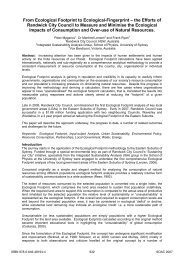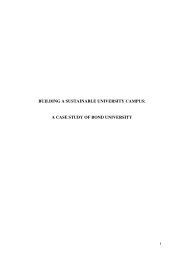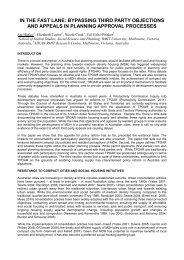How dense are we? Another look at urban density and transport ...
How dense are we? Another look at urban density and transport ...
How dense are we? Another look at urban density and transport ...
- No tags were found...
Create successful ePaper yourself
Turn your PDF publications into a flip-book with our unique Google optimized e-Paper software.
<strong>How</strong> <strong>dense</strong> <strong>are</strong> <strong>we</strong>?rigorous definitions of <strong>density</strong> th<strong>at</strong> could be used for compar<strong>at</strong>ive purposes, but <strong>we</strong>re beingignored. McLoughlin would not have been impressed to read Melbourne 2030!Defining <strong>density</strong>The key point Fooks <strong>and</strong> McLoughlin make is th<strong>at</strong> useful measures of <strong>density</strong> should bebased on the <strong>are</strong>a of <strong>urban</strong>ised l<strong>and</strong>, not on arbitrary administr<strong>at</strong>ive boundaries. The whole<strong>urban</strong> <strong>are</strong>a should be counted, not just th<strong>at</strong> portion lying with the boundaries of a centralmunicipality: <strong>urban</strong>ised New York extends far beyond the five boroughs of New York City,into Long Isl<strong>and</strong> <strong>and</strong> even the neighbouring st<strong>at</strong>es of Connecticut <strong>and</strong> New Jersey.Conversely, only <strong>urban</strong>ised l<strong>and</strong> should be counted when measuring <strong>density</strong>, someasurements must exclude non-<strong>urban</strong> l<strong>and</strong> th<strong>at</strong> happens to lie within city boundaries.Density can be examined in more detail by distinguishing bet<strong>we</strong>en residential <strong>and</strong> nonresidentiall<strong>and</strong>. Using McLoughlin’s nomencl<strong>at</strong>ure, Net residential <strong>density</strong> is calcul<strong>at</strong>ed byconsidering only the residential blocks on which houses <strong>are</strong> built. Gross residential <strong>density</strong>includes non-residential uses found within residential neighbourhoods, such as local schools<strong>and</strong> parks. Overall <strong>urban</strong> <strong>density</strong> includes all other <strong>urban</strong> uses, such as industrial <strong>are</strong>as,<strong>transport</strong> terminals <strong>and</strong> regional open space.Different definitions of <strong>density</strong> will n<strong>at</strong>urally produce different figures. So when comparingthe densities of different cities, or parts of cities, it is important to use consistent definitions,count only <strong>urban</strong>ised l<strong>and</strong> <strong>and</strong> count all the <strong>urban</strong>ised l<strong>and</strong>. Most discussions of <strong>density</strong> by<strong>urban</strong> planners have failed this test. Countless discussions of metropolitan <strong>are</strong>as havecomp<strong>are</strong>d ‘densities’ of inner <strong>and</strong> outer municipalities based on the whole <strong>are</strong>a withinmunicipal borders. Since outer municipalities often incorpor<strong>at</strong>e large <strong>are</strong>as of non-<strong>urban</strong> l<strong>and</strong>,the result always appears to be a steep decline in <strong>density</strong> with distance from the centre. Butthis decline is likely to be exagger<strong>at</strong>ed or even completely illusory: Max Neutze’s c<strong>are</strong>fulanalysis of Adelaide three decades ago found th<strong>at</strong> the app<strong>are</strong>nt decline in <strong>density</strong> was ast<strong>at</strong>istical artefact, with residential densities actually highest on the <strong>urban</strong> fringe, <strong>and</strong> overall<strong>urban</strong> densities roughly constant throughout the metropolis (Neutze, 1981, p. 67).Newman <strong>and</strong> Kenworthy expressly <strong>at</strong>tempted to avoid problems of this kind in their multicitycomparison, by using a definition th<strong>at</strong> corresponds to overall <strong>urban</strong> <strong>density</strong> in the abovediscussion. They <strong>we</strong>re successful in most cases, but not all. In some cities, especially inEurope, l<strong>and</strong> use d<strong>at</strong>a for complete <strong>urban</strong>ised <strong>are</strong>as proved difficult to obtain, <strong>and</strong> only thecentral municipality was studied. Because the central municipality is the most <strong>dense</strong>lypopul<strong>at</strong>edpart of the region, this means the <strong>density</strong> figures <strong>are</strong> overst<strong>at</strong>ed for all such cities. Inthe case of the 1999 Intern<strong>at</strong>ional Sourcebook, this means Amsterdam, Brussels, Frankfurt,Hamburg, Munich, Stockholm <strong>and</strong> Vienna – the majority of the European cities shown on thefamous hyperbola (Kenworthy et al, 1999, pp. 27-32: the 2001 D<strong>at</strong>abase does not specifyhow <strong>urban</strong> boundaries <strong>we</strong>re defined).A similar problem affected Newman <strong>and</strong> Kenworthy’s 1989 <strong>and</strong> 1999 <strong>density</strong> d<strong>at</strong>a forToronto, which as <strong>we</strong> have seen was confined to the City of Toronto. The resultingoverst<strong>at</strong>ement of <strong>density</strong> was magnified by the fact th<strong>at</strong> the gross residential <strong>are</strong>a wasinadvertently used as the basis for calcul<strong>at</strong>ing <strong>density</strong>, instead of the overall <strong>urban</strong> <strong>are</strong>a. Thiscan be seen clearly from the map of <strong>urban</strong>ised Toronto in the Intern<strong>at</strong>ional Sourcebook,which shows Toronto <strong>and</strong> York Universities, two large cemeteries, the main racecourse <strong>and</strong>numerous parks as non-<strong>urban</strong> (Kenworthy et al, 1999, p. 375). These deficiencies <strong>we</strong>re






